Jayachamarajendra Wadiyar
| Jayachamarajendra Wadiyar GCB GCSI | |
|---|---|
| Maharaja of Mysore | |
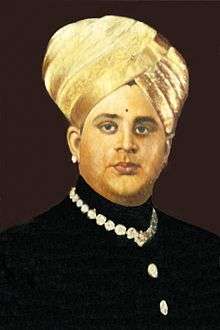 | |
| Reign | 3 August 1940 — 23 September 1974 |
| Coronation | 8 September 1940, Palace of Mysore |
| Predecessor | Krishnaraja Wadiyar IV |
| Successor | Srikanta Wadiyar |
| Born |
18 July 1919 Mysore Palace, Mysore, Kingdom of Mysore, India |
| Died |
23 September 1974 (aged 55) Bangalore Palace, Bangalore, India |
| Spouse | Tripura Sundari Ammani |
| Issue | Princess Gayatri Devi Avaru(1946-1974),Princess Meenakshi Devi Avaru(1951-2015),Prince Srikantadatta Narasimharaja Wadiyar(1953-2013), and Princess Kamakshi Devi Avaru(1954-now) Princess Indrakshi Devi Avaru(1956-now) Princess Vishalakshi Devi Avaru(1962-now) |
| House | Wadiyar dynasty |
| Father | Yuvaraja Kanteerava Narasimharaja Wadiyar |
| Mother | Yuvarani Kempu Cheluvaja Amanni |
| Religion | Hinduism |



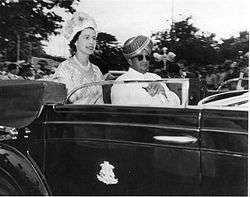
Maharaja Sri Sir Jayachamarajendra Wadiyar Bahadur, Maharaja of Mysore[1] GCB GCSI (18 July 1919 – 23 September 1974), aka Jaya Chamarajendra Wadiyar[1] was the 25th and last Maharaja of the princely state of Mysore from 1940 to 1950. He was a noted philosopher, musicologist, political thinker and philanthropist and the Founder-President of Vishva Hindu Parishad (World Hindu Council).[2]
Biography
He was the only son of Yuvaraja Kanteerava Narasimharaja Wadiyar and Yuvarani Kempu Cheluvaja Amanni. Wodiyar dynasty is the only Royal Family from Mysore and belong to Lunar Dynasty (Chandrvanshi Kshatriya lineage). He graduated from the Maharaja's College, Mysore in 1938, earning five awards and gold medals. He was married the same year, on 15 May 1938. He toured Europe during 1939, visiting many associations in London and became acquainted with many artists and scholars. He ascended the throne of the Kingdom of Mysore on 8 September 1940 after the demise of his uncle Maharaja Nalvadi Krishnaraja Wodeyar.
He signed the Instrument of Accession with the Dominion of India on the eve of India attaining Independence in August 1947. The princely state of Mysore was merged with the Republic of India on 26 January 1950. He held the position of Rajpramukh of the State of Mysore from 26 January 1950 to 1 November 1956. After the integration of the neighboring Kannada-majority parts of the States of Madras and Hyderabad, he became the first Governor of the reorganized or unified State of Mysore, 1 November 1956 to 4 May 1964 and was the Governor of the State of Madras from 4 May 1964 to 28 June 1966.
ಎಲ್ಲರೂ ಸಿಂಹಾಸನಾಧೀಶರಾಗಿ ಮಹಾರಾಜರಾದರೆ ಇವರು ಅದನ್ನು ತ್ಯಜಿಸಿಯೇ ಮಹಾರಾಜರಾದರು (Every monarch in history has become king ascending thrones, while he became the greatest king descending one).
Kuvempu, Kannada National Poet, on the Maharaja's merging his kingdom with the Indian Union
The Maharaja died at the age of 55 on 23 September 1974, and he was the last living premier prince of the Indian Empire with a 21-gun salute.
Sports
He was a good horseman and a tennis player who helped Ramanathan Krishnan to participate at Wimbledon. He was also well known for his marksmanship and was highly sought-after by his subjects whenever a rogue elephant or a maneating tiger attacked their immediate surroundings. There are many wildlife trophies attributed to him in the Palace collections. He was responsible for the famous cricketer/off-spin bowler, E. A. S. Prasanna's visit to West Indies as his father was otherwise reluctant to send him.
Music
He was a connoisseur of both western and Carnatic (South Indian classical) music and an acknowledged authority of Indian Philosophy. He helped the Western world discover the music of a little-known Russian composer Nikolai Medtner (1880–1951), financing the recording of a large number of his compositions and founding the Medtner Society in 1949. Medtner's Third Piano Concerto is dedicated to the Maharaja of Mysore. He became a Licentiate of the Guildhall School of Music, London and honorary Fellow of Trinity College of Music, London, in 1945. Aspirations to become a concert pianist were cut short by the untimely death of both his father the Yuvaraja Kanteerava Narasimharaja Wadiyar in 1939 and his uncle the Maharaja Krishnaraja Wadiyar IV in 1940, when he succeeded the throne of Mysore.
He was the first president of the Philharmonia Concert Society, London in 1948.[3] See below copy of the programme sheets of some of the earliest concerts held at Royal Albert Hall on 13 April, 27 April – 11 May 1949.
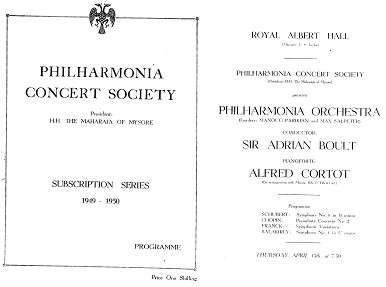
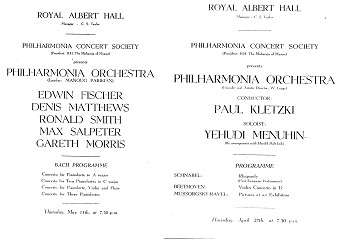
Walter Legge, who was invited to Mysore by the Maharaja in this regard has stated:
- "The visit to Mysore was a fantastic experience. The Maharajah was a young man, not yet thirty. In one of his palaces he had a record library containing every imaginable recordings of serious music, a large range of loud speakers, and several concert grand pianos...."
- "In the weeks I stayed there, the Maharajah agreed to paying for the recordings of the Medtner piano concertos, an album of his songs, and some of his chamber music; he also agreed to give me a subvention of 10,000 pounds a year for three years to enable me to put the Philharmonia Orchestra and the Philharmonia Concert society on firm basis...."
| Mysore Kings (1399–present) | |
| Feudatory Monarchy (As vassals of Vijayanagara Empire) (1399–1553) | |
| Yaduraya Wodeyar | (1399–1423) |
| Chamaraja Wodeyar I | (1423–1459) |
| Timmaraja Wodeyar I | (1459–1478) |
| Chamaraja Wodeyar II | (1478–1513) |
| Chamaraja Wodeyar III | (1513–1553) |
| Absolute Monarchy (Independent Wodeyar Kings) (1553–1761) | |
| Timmaraja Wodeyar II | (1553–1572) |
| Chamaraja Wodeyar IV | (1572–1576) |
| Chamaraja Wodeyar V | (1576–1578) |
| Raja Wodeyar I | (1578–1617) |
| Chamaraja Wodeyar VI | (1617–1637) |
| Raja Wodeyar II | (1637–1638) |
| Narasaraja Wodeyar I | (1638–1659) |
| Dodda Devaraja Wodeyar | (1659–1673) |
| Chikka Devaraja Wodeyar | (1673–1704) |
| Narasaraja Wodeyar II | (1704–1714) |
| Krishnaraja Wodeyar I | (1714–1732) |
| Chamaraja Wodeyar VII | (1732–1734) |
| Krishnaraja Wodeyar II | (1734–1761) |
| Puppetry Monarchy (Under Haider Ali and Tipu Sultan) (1761–1799) | |
| Krishnaraja Wodeyar II | (1761–1766) |
| Nanjaraja Wodeyar | (1766–1770) |
| Chamaraja Wodeyar VIII | (1770–1776) |
| Chamaraja Wodeyar IX | (1776–1796) |
| Puppetry Monarchy (Under British Rule) (1799–1831) | |
| Krishnaraja Wodeyar III | (1799–1831) |
| Titular Monarchy (Monarchy abolished) (1831–1881) | |
| Krishnaraja Wodeyar III | (1831–1868) |
| Chamaraja Wodeyar X | (1868–1881) |
| Absolute Monarchy Monarchy restored (As allies of the British Crown) (1881–1947) | |
| Chamaraja Wodeyar X | (1881–1894) |
| Krishnaraja Wodeyar IV | (1894–1940) |
| Jayachamaraja Wodeyar | (1940–1947) |
| Constitutional Monarchy (In Dominion of India) (1947–1950) | |
| Jayachamaraja Wodeyar | (1947–1950) |
| Titular Monarchy (Monarchy abolished) (1950–present) | |
| Jayachamaraja Wodeyar | (1950–1974) |
| Srikanta Wodeyar | (1974–2013) |
| Yaduveera Chamaraja Wadiyar | (2015–present) |
This largesse proved sufficient to transform Legge's fortunes in 1949. He was able to engage Herbert von Karajan as conductor. The repertory the young Maharajah wished to sponsor were Balakirev's Symphony, Roussel's Fourth Symphony, Busoni's Indian Fantasy etc. The association produced some of the most memorable recordings of the post-war period.
The Maharaja also enabled Richard Strauss's last wish to be fulfilled by sponsoring an evening at the Royal Albert Hall by London's Philharmonia Orchestra with German conductor Wilhelm Furtwängler in the lead and soprano Kirsten Flagstad singing his Four Last Songs in 1950.
The Maharaja was equally a good critic of music. When asked by Legge to pass judgement on recent additions to the EMI catalogue, his views were as trenchant as they were refreshingly unpredictable. He was thrilled by Karajan's Vienna Philharmonic recording of Beethoven's Fifth Symphony ('as Beethoven wished it to be'), held Furtwängler's recording of the Fourth Symphony in high esteem, and was disappointed by Alceo Galliera's account of the Seventh Symphony, which he would have preferred Karajan to record. Above all, expressed serious doubts about Arturo Toscanini's recordings. 'The speed and energy are those of a demon', he wrote to Legge, 'not an angel or superman as one would ardently hope for'. One of the reasons he so admired Furtwängler's Beethoven was that it was 'such a tonic after Toscanini's highly strung, vicious performances'.
Writing in the July 1950 edition of "THE GRAMOPHONE" Walter Legge sums Maharajs's monumental contribution to Western Classical Music:
....Many more correspondents have written expressing their admiration for the vision, constructive enterprise and generosity of the young Indian Prince who conceived this plan, and who is making it possible for the music lovers throughout the world to learn, enjoy and study works which but for his knowledge and love of music, would never have been recorded.....
After becoming Maharaja, he was initiated to the Indian classical music (Carnatic music) due to the cultural vibrancy which prevailed in the Mysore court till then. He learnt to play veena under Vid. Venkatagiriappa and mastered the nuances of carnatic music under the tutelage of veteran composer and Asthan Vidwan Sri. Vasudevacharya. He was also initiated into the secrets of Shri Vidya as an upasaka (under assumed name Chitprabhananda) by his guru Shilpi Siddalingaswamy. This inspired him to compose as many as 94 carnatic music krutis under the assumed name of Shri Vidya. All the compositions are in different ragas and some of them for the first time ever. In the process He also built three temples in Mysore city: Bhuvaneshvari Temple and Gayatri Temple, located inside the Mysore Palace Fort, and Sri Kamakaameshwari Temple, situated on Ramanuja Road, Mysore. All three temples were sculpted by the maharaja's guru and famous sculptor, Shilpi Siddalingaswamy. His 94 compositions is published by his son-in law Sri. R.Raja Chandra as " Sree Vidyaa Gaana Vaaridhi" in 2010. The book is edited by Sri. S. Krishna Murthy grandson of Maharaja's Guru, Sri. Mysore Vasudevacaharya.
Many noted Indian musicians received patronage at his court, including Mysore Vasudevachar, Veena Venkatagiriyappa, B. Devendrappa, V. Doraiswamy Iyengar, T. Chowdiah, Tiger Vardachar, Chennakeshaviah, Titte Krishna Iyengar, S. N. Mariappa, Chintalapalli Ramachandra Rao, R. N. Doreswamy, H. M. Vaidyalinga Bhagavatar.
The patronage and contribution of Wadiyars to carnatic music was researched in the 1980s by Prof. Mysore Sri V. Ramarathnam, Retired First Principal of the University College of Music and Dance, University of Mysore. The research was conducted under the sponsorship of University Grants Commission, Government of India. Prof. Mysore Sri V. Ramarathnam authored the book Contribution and Patronage of Wadiyars to Music that was published Kannada Book Authority, Bangalore.
Literary works
- The Quest for Peace: an Indian Approach, University of Minnesota, Minneapolis 1959.
- Dattatreya: The Way & The Goal, Allen & Unwin, London 1957.
- The Gita and Indian Culture, Orient Longmans, Bombay, 1963.
- Religion And Man, Orient Longmans, Bombay, 1965. Based on Prof. Ranade Series Lectures instituted at Karnataka University in 1961.
- Avadhuta: Reason & Reverence, Indian Institute of World Culture, Bangalore, 1958.
- An Aspect Of Indian Aesthetics, University of Madras, 1956.
- Puranas As The Vehicles Of India's Philosophy Of History, Journal Purana, issue #5, 1963.
- Advaita Philosophy, Sringeri Souvenir Volume, 1965, pages 62–64.
- Sri Suresvaracharya, Sringeri Souvenir Volume, Srirangam, 1970, pages 1–8.
- Kundalini Yoga, A review of "Serpent Power" by Sir John Woodroff.
- Note on Ecological Surveys to precede Large Irrigation Projects- Wesley Press, Mysore; 1955
- African Survey-Bangalore Press; 1955
- The Virtuous Way of Life - Mountain Path - July 1964 edition
He also sponsored the translation of many classics from Sanskrit to Kannada as part of the Jayachamaraja Grantha Ratna Mala, including 35 parts of the Rigveda. These are essentially Ancient sacred scriptures in Sanskrit till then not available in Kannada language comprehensively. All the books contains original text in Kannada accompanied by Kannada translation in simple language for the benefit of common man. In the history of Kannada literature such a monumental work was never attempted ! As Late H.Gangadhara Shastry - Asthan (court) Astrologer and Dharmadhikari of Mysore Palace - who himself has contributed substantially in the above works -has stated that Maharaja used to study each and everyone of these works and discuss them with the authors. It seems on a festival night (on shivaratri), he was summoned in the middle of the night and advised him to simplify the use of some difficult Kannada words in one of the books.
During his reign, he also encouraged Historical research on Modern lines and this finds an echo in the dedication of the encyclopedic work by C. Hayavadana Rao entitled " History of Mysore" in three voluminous work published from 1943-46. Authors words are quite illuminating and worth quoting. Author says:
"Dedicated by gracious permission to His Highness, Sri Jayacahamaraja Wadiyar Bahadur, Maharaja of Mysore- Ruler, Scholar, and patron of Arts and sciences and supporter of every good cause aiming at the moral and material progress of the people - In token of His Highness' deep and abiding interest in the scientific study of History and pursuit of Historical Research along modern lines".
It aptly sums up the personality of the Maharaja. It is matter of regret that the Author could not complete the work as originally intended and had to stop at the year 1949 as Maharaja had to accede to the wishes of his people and merge his Kingdom with the Republic of India in 1950.
Titles
- 1919-11 March 1940: Maharajkumar Sri Jayachamarajendra Wadiyar
- 11 March-3 July 1940: His Highness Yuvaraja Sri Jayachamarajendra Wadiyar Bahadur, Yuvaraja of Mysore
- 3 July 1940 – 1945: His Highness Maharaja Sri Jayachamarajendra Wadiyar Bahadur, Maharaja of Mysore
- 1945-1946: His Highness Maharaja Sri Sir Jayachamarajendra Wadiyar Bahadur, Maharaja of Mysore, GCSI
- 1946-1948: His Highness Maharaja Sri Sir Jayachamarajendra Wadiyar Bahadur, Maharaja of Mysore, GCB, GCSI
- 1948-1962: Colonel His Highness Maharaja Sri Sir Jayachamarajendra Wadiyar Bahadur, Maharaja of Mysore, GCB, GCSI
- 1962-1974: Major-General His Highness Maharaja Sri Sir Jayachamarajendra Wadiyar Bahadur, Maharaja of Mysore, GCB, GCSI
- 1950-1956: Colonel His Excellency Sri Sir Jayachamarajendra Wadiyar, GCB, GCSI, Rajpramukh of the State of Mysore
- 1956-1962: Colonel His Excellency Sri Sir Jayachamarajendra Wadiyar, GCB, GCSI, Governor of Mysore State
- 1962-1964: Major-General His Excellency Sri Sir Jayachamarajendra Wadiyar, GCB, GCSI, Governor of Mysore State
- 1964-1966: Major-General His Excellency Sri Sir Jayachamarajendra Wadiyar, GCB, GCSI, Governor of Madras State
Honours
(ribbon bar, as it would look today)
![]()
![]()
![]()
![]()
- The British Government honored him with the GCSI in 1945 and GCB in 1946.
- Doctor of Literature from the University of Queensland, Australia
- Doctor of Literature from the Annamalai University, Tamil Nadu.
- Doctor of Law from the Banaras Hindu University
- Doctor of Laws, honoris causa from University of Mysore (1962).
- Fellow & president of Sangeet Natak Academy, New Delhi, 1966
- First Chairman of the Indian Wild Life Board.
- Founder-president of the Vishwa Hindu Parishad.
Family
Sisters:
- Princess Vijaya Lakshmi Ammani, later Rani Vijaya Devi of Kotda Sangani.
- Princess Sujaya kantha Ammani, later the Thakurani Sahiba of Sanand.
- Princess Jaya Chamunda Ammani Avaru, later H.H. Maharani Sri Jaya Chamunda Ammani Avaru Sahiba, Maharani of Bharatpur.
Wives:
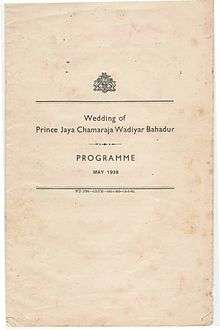
- H.H. Maharani Sathya Prema Kumari of Charkhari. The wedding was held on 15 May 1938. The marriage failed; the Maharani settled at Jaipur. There were no children by this marriage.
- H.H. Maharani Tripura Sundari Ammani Avaru. The wedding was held on 30 April 1944. This marriage produced six children.
Both the Maharanis died in 1983 within a span of 15 days.
Children:
- Princess Gayatri Devi Avaru, (1946–1974), who predeceased her father due to cancer.[4]
- Princess Meenakshi Devi Avaru, (1951-2015).
- HH Maharaja Sri Srikanta Wadiyar (1953-2013).
- Princess Kamakshi Devi Avaru, b.1954.
- Princess Indrakshi Devi Avaru, b.1956.
- Princess Vishalakshi Devi Avaru, b.1962.
References
- 1 2 The Wodeyar Dynasty
- ↑ Ikegame, Aye (2013). Princely India Re-imagined: A Historical Anthropology of Mysore from 1799 to the present. Routledge. p. 67. ISBN 9781136239090.
- ↑
- ↑ Devi, Meenakshi (17 June 2007). "My daddy, His Highness, the Maharaja of Mysore". Deccan Herald. Retrieved 15 January 2014.
External links
| Wikimedia Commons has media related to Jayachamarajendra Wadiyar. |
- Maharaja of Mysore H.H. Dr.Jaya Chamaraja Wadiyar on YouTube
- Maharaja of Mysore H.H. Dr.Jaya Chamaraja Wadiyar : V- II on YouTube
- Speech as a Freemason
- Profile at the Mysore Samachar
- Jaya Chamaraja, the last Maharaja
| Jayachamarajendra Wadiyar Born: 1919 Died: 1974 | ||
| Regnal titles | ||
|---|---|---|
| Preceded by Krishna Raja Wadiyar IV (as Raja of Mysore) |
Maharaja of Mysore 1940–1950 |
Succeeded by Monarchy abolished (Merge within the Republic of India) |
| Political offices | ||
| Preceded by None; post created 26 January 1950 |
Rajpramukh of the State of Mysore 1950–1956 |
Succeeded by Post abolished Abolished by the Government of India 31 October 1956 |
| Preceded by None; post created 31 October 1956, following the abolition of the position of Rajpramukh |
Governor of Mysore State 1956–1964 |
Succeeded by S.M. Sriganesh |
| Preceded by Bhishnuram Medhi |
Governor of Madras State 1964–1966 |
Succeeded by Ujjal Singh |
| Titles in pretence | ||
| Preceded by None |
— TITULAR — Maharaja of Mysore 1950–1974 |
Incumbent Heir: Srikanta Datta Narsimharaja Wodeyar |